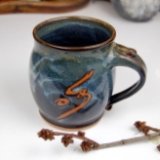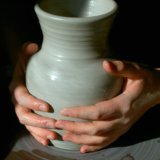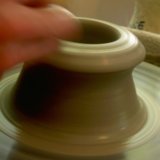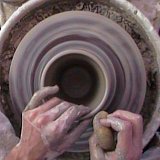|
Ceramic Kiln FiringGetting access to a ceramic kiln can be one of the biggest hurdles for a beginning potter. I know it was for me, especially once I left college. I didn't appreciated the facilities that I had access to when I was in college. We had raku kilns, pit firing, gas kilns, gigantic front loading kilns, and several large electric kilns. Over the years since then, I have considered myself lucky to have access even to any kiln, as long as I can fire my pottery. Even now, my kiln isn't technically mine. I'm borrowing it from a friend. She had been packing the kiln around for years looking for a chance to hook it up. I just happened to have the perfect spot for it with an all important 220 volt plug nearby. So, we pooled our resources, and I'm babysitting her kiln. That's how pottery is. It becomes a community event, which makes sense because it's been that way for thousands of years. Anyway, it's a great kiln. It's not computer fired or anything, but it fires right every time. It's an old Cress kiln with a classic kiln sitter. Firing Using a Kiln SitterA kiln sitter is a device that tells the kiln when to shut off. You place a small pyrometric cone between three levers and when it melts, the levers turn off the kiln. It works much better than a pyrometer because the cone measures "heat work", which is time AND temperature, whereas a pyrometer only measures temperature. This gives you a very reliable measure of exactly how the pots have been fired. (I always place a cone pack inside with different temperature cones. These cones confirm that the kiln sitter did, or did not, do it's job correctly.) My kiln also has a thumb wheel, which allows me to start the firing off slowly and gradually work up to greater increases in temperature as the firing progresses. It can also be fired faster or slower depending on what I am firing. For example, I always fire bisque very slowly, especially at the beginning. It needs time to heat slowly so the moisture can escape from the clay gently. This prevents pots from cracking and exploding. I fire the bisque firing on the slowest setting possible. On the other hand, for glaze I will fire fairly rapidly. The moisture has all been cooked out of the clay in the bisque firing, so the coast is clear. This works out well, since the glaze has to be fired to a higher temperature. If I had to fire it slowly it would take two days just to heat the kiln, let alone waiting for it to cool. Soaking the KilnAlso, when firing glazed pots, I always soak the ceramic kiln for an hour before turning it off. Soaking is when you hold the temperature in the kiln at it's highest temperature before you allow it to cool. Soaking is good for glaze because it allows it to even out before cooling. It allows any blisters and bubbles a chance to smooth out before the glaze hardens and preserves them forever. Soaking is the trickiest part of using a kiln sitter. The sitter will turn the kiln off when the cone melts. So to soak the kiln I have to turn it back on for an hour at a low temperature to "hold" the top temperature or "soak" the kiln. The kiln has to be monitored closely toward the end of the firing. If the sitter turns off and the ceramic kiln begins to cool for an hour or two, the valuable effects of soaking may be lost. By the way, I always allow the kiln to cool for 48 hours after any firing. Unless you are in a major, desperate rush to finish your pots, you don't want to open a hot kiln. The shock to your pottery from rapid temperature change is not good for it. Besides, the mental game of checking the kiln every hour, and then trying to decide how cool is cool enough to risk it, can waste a lot of time and energy. For any firing under cone 6, you can be sure that 48 hours is enough time for it to cool. In the mean time, go make some more pottery.
Ceramic Kiln Firing ScheduleRegardless of whether I am firing bisque or glaze I like to fire over night. The reason for this is that, as I mentioned about, with a kiln sitter it is important to closely monitor the end of the firing. The rest of the firing progresses pretty automatically. Bisque Firing ScheduleFor a typical bisque firing I would set the kiln on the slowest firing setting. Here's an example of how a cone 08 bisque firing would progress: 8pm - Make a cone pack with a cone 09, cone 08, and cone 07 in it, and load the kiln. 11pm - Turn the kiln on with the lid propped open 2 inches and the peep hole plugs removed. 12:30pm - Close the lid and put the peep hole plugs in so the kiln is completely closed. Let the kiln fire over night. 7:30am - Look through peep hole to check cone pack. If cone 09 has fallen, check kiln every 20 minutes until cone 08 has fallen. If cone 08 bends and kiln sitter hasn't turned off, turn kiln off manually. Allow your ceramic kiln to cool for 48 hours before opening. Open the kiln and glaze the pots. Glaze Firing ScheduleFor a glaze firing I set the kiln on the fastest setting. Here's an example of how a cone 5 glaze firing would progress: 8pm - Make a cone pack with a cone 4, cone 5, and cone 6 in it, and load the kiln. 11pm - Turn the kiln on with the lid propped open 2 inches and the peep hole plugs removed. 12:00pm - Close the lid and put the peep hole plugs in so the kiln is completely closed. Let the kiln fire over night. 7:30am - Look through peep hole to check cone pack. If cone 4 has fallen, check kiln every 20 minutes until cone 5 has fallen. If cone 5 bends and the kiln sitter still hasn't turned off, turn kiln down to lowest setting and soak for one hour. Using the lowest setting keeps the ceramic kiln from cooling too rapidly, but isn't enough to increase the temperature, thereby over firing the pottery. After one hour of soaking, turn kiln off manually. Allow your ceramic kiln to cool for 48 hours before opening. Open the kiln and play with the beautiful pots. Keep in mind that you can do a lot more with your firing by customizing your firing schedule, especially with a computerized kiln. On the other hand, an experienced potter can fire a kiln by monitoring the cone pack inside the kiln and little else. My best tip: If in doubt fire a small test load. It's better to ruin 3 pots than 30. Besides that, fire often and Happy Potting.
Return From Ceramic Kiln |
Learn Right
The First Time
Pottery on the Wheel for Beginners
is a complete beginners guide
to learning pottery.
It will
take you from
never having touched clay
to creating finished pottery
you can use every day.
Also read it on Kindle
Featured Pages
Choose Your Wheel
Thank you so much for
visiting my website!
Discover How I Made It!
Happy Potting!
- Steve










